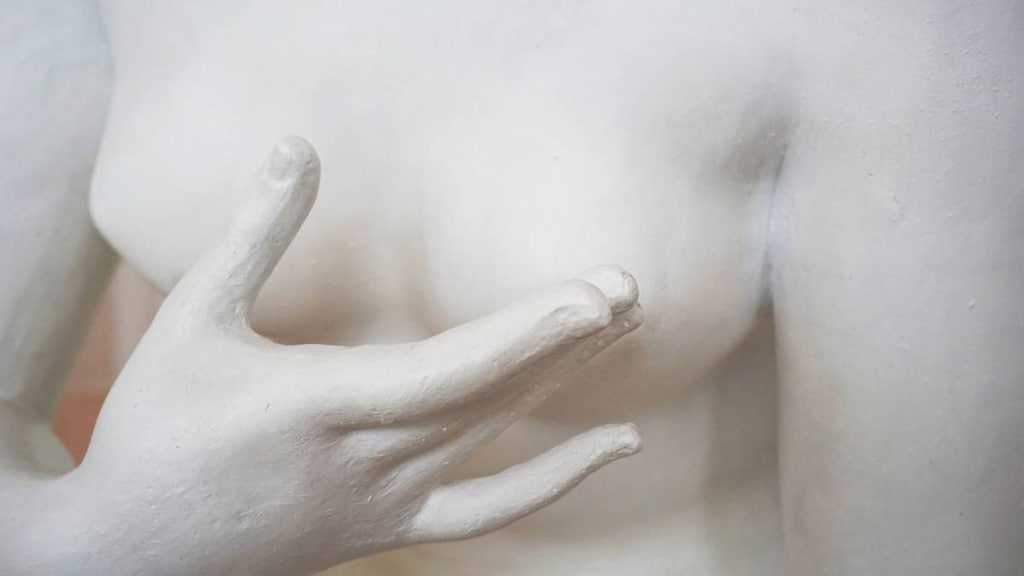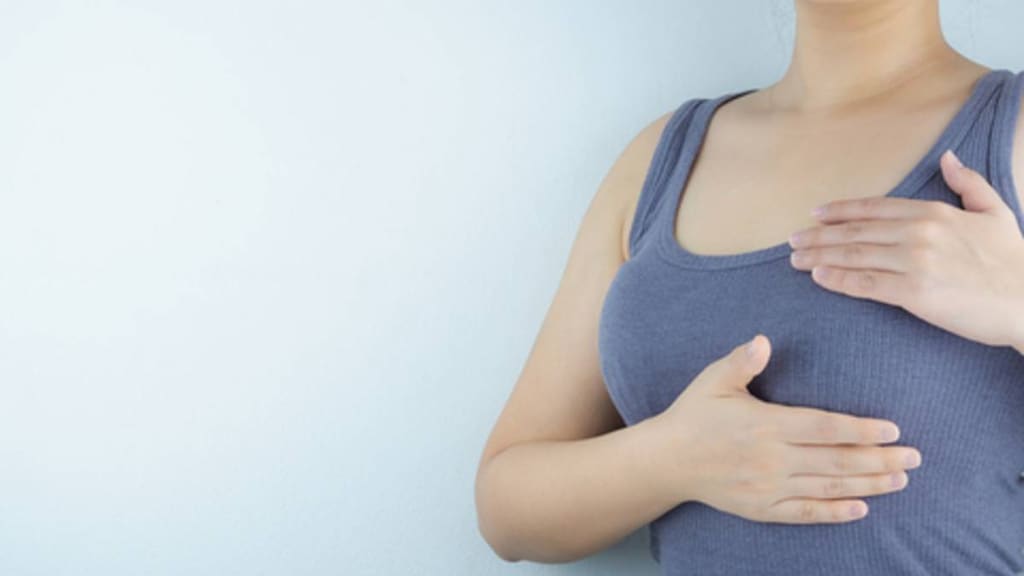Breast Cancer Signs

One in eight women - about 12 percent - will be diagnosed with invasive breast cancer at some point in their life, according to BreastCancer.org. That translates to nearly 270,000 women facing a diagnosis of invasive breast cancer each year in the United States.
Men can get breast cancer, too, though their risk is much lower. About one in 883 American males will be diagnosed each year, reports BreastCancer.org.
Breast cancer in women and men occurs when breast cells grow uncontrollably and are abnormal. It's most likely to begin in two of the three main parts of the breast: either in the lobules, which are glands that produce milk, or in the ducts, which are tubes that carry milk to the nipple. The third part of the breast consists of connective tissue, which surrounds the lobules and ducts and holds it all together.
Mammograms, which are X-rays of your breasts, are used to find breast cancer in its early stages, when it is easiest to treat. Breast cancers may show up on mammograms as many as three years before they can be felt, according to the Centers for Disease Control and Prevention.
When in its early stages, you can have breast cancer long before you see or feel that anything is wrong. That’s why the American Cancer Society and others recommend women undergo mammograms regularly. Talk to your doctor about how often you should have a mammogram and at what age you should start. It will depend on your personal history, family history and your level of risk.
What’s that lump?
Usually, by the time you can feel a lump, your cancer has been growing for some time — possibly up to five years. You’re not likely to feel a lump until it is at least 1 centimeter in size.
However, if you feel a lump in your breast, it might not be cancer. It could be a benign condition such as a cyst, which is a fluid-filled sac, or a fibroadenoma, which is a fibrous tumor, according to the Susan G. Komen organization. Cysts are more common in women younger than 40, while fibroadenomas most often occur in women in their 20s and 30s.
Even if what you feel is benign, if it’s something new or different, you should have it checked out by your doctor to be sure.
A lump that is more apt to be cancer is likely to be irregular in shape and feel firm or solid, according to the Dana-Farber Cancer Institute. Breast cancers feel more like rocks and are less likely to move than benign tumors.
If it’s cancer, it’s not likely to hurt. However, in a small number of women, painful lumps can turn out to be malignant.
If you find a lump, it can be anywhere in your breast.
Breast self-awareness
Most medical organizations no longer push women to do breast self-exams because they haven’t proven to be a reliable breast cancer screening tool. However, the same organizations recommend that women be familiar with their breasts so if changes do occur, they will notice and report them to their doctors sooner rather than later. Use your eyes and hands to examine your breasts and be on the lookout for changes.
Remember that your breasts will feel different during different times of your monthly cycle.
To get to know your breasts well, follow these tips from the Mayo Clinic, BreastCancer.org and the National Breast Cancer Foundation:
- Be consistent. Make it a habit to examine your breasts at the same time each month. If you’re still menstruating, schedule your self-exam a few days after your period is over. That’s when your breasts are less tender. If you’re menopausal, choose a day you can remember easily, such as the first Monday of every month.
- Keep records. Make a small map of your breasts and take notes on what you feel where. Your descriptions can help you remember what's normal for you. Note: It is possible for lumps or bumps to appear from month to month and then disappear.
- Check it thrice. Examine your breasts in front of a mirror. Look for any changes, including dimpling and puckering. Examine your breasts when showering, too. It’s easier to run your hands over all areas of your breasts when your skin is wet. And finally, also examine your breasts while lying down so that your breast tissue spreads out.
- Use different pressures. Light pressure is best to feel the tissue closest to your skin. Press a little harder as you go a little deeper. You will need firm pressure to feel close to your chest and ribs.
Don’t be in a rush. If you hurry, you could miss changes. Take your time.
Other changes that could signal breast cancer
Everyone thinks of lumps when they think of breast cancer. However, lumps are not the only sign of breast cancer.
Here are other changes in your breasts that might point to a problem:
- Your breast is a different size or shape than normal.
- One breast seems larger than the other when they’ve been similar in size until now.
- Your breast is swollen.
- Your skin is dimpling. This can be anywhere on your breast.
- Your nipple is painful, or it turns inward.
- Your skin is red, scaly or seems to be thickening either near the nipple or elsewhere. Some describe this as looking like an orange peel.
- You have a discharge from your breast that’s not milk but rather clear or bloody. (A milky discharge when you’re not breastfeeding should be checked, too, although it’s not likely to be linked to breast cancer.)
- You notice a lump underneath your arm.
None of these changes necessarily mean you have breast cancer. However, it's important that you discuss them with your doctor and have them checked out promptly. If they do signal cancer, the earlier you start your treatment the more likely it is to be successful, the American Cancer Society says.
Most people with breast cancer are likely to have only one or two of these symptoms initially, the National Breast Cancer Foundation says.
What does breast cancer feel like in men?
While the number of men who get breast cancer is minuscule compared with women, men can get breast cancer. When they do it feels similar to breast cancer in women.
The Mayo Clinic says that signs and symptoms of breast cancer in men include:
- A lump or thickening in breast tissue that is painless.
- A change in the skin surrounding the breast. It may dimple, pucker or become red or scaly.
- Changes in the nipple. It may become red and scaly, or it may turn inward.
- Discharge from your nipple.
What happens during diagnosis
Don’t wait for your next appointment to bring any of these changes to your doctor. Chances are good that it may not be breast cancer and instead is something less serious. But, you need to have a doctor diagnose your symptoms and determine the cause.
Your doctor is most likely to order diagnostic tests to determine whether your lump or breast changes are benign or malignant. Diagnostic exams can include a mammogram (X-ray), an ultrasound and a magnetic resonance imaging (MRI) exam. Your doctor also might order a biopsy, during which a sample tissue is removed from the suspected area and examined under a microscope in the pathology lab. If the tests show possible breast cancer, your doctor is likely to order further lab tests to determine the type of cancer you may have and how to best treat it.
Two key things to remember:
- Only a small percentage of lumps turn out to be breast cancer.
- It’s important to be proactive about your body. You know it best.
Article references
- BreastCancer.org, U.S. Breast Cancer Statistics https://www.breastcancer.org/symptoms/understand_bc/statistics
- BreastCancer.org, What is Breast Cancer? https://www.breastcancer.org/symptoms/understand_bc/what_is_bc
- Centers for Disease Control and Prevention, What is Breast Cancer? https://www.cdc.gov/cancer/breast/basic_info/what-is-breast-cancer.htm
- Centers for Disease Control and Prevention, What is a Mammogram? https://www.cdc.gov/cancer/breast/basic_info/mammograms.htm
- American Cancer Society, American Cancer Society Guidelines for Breast Cancer Screening https://www.cancer.org/latest-news/special-coverage/american-cancer-society-breast-cancer-screening-guidelines.html
- Providence Health & Services, Ask an Expert: Breast cancer growth rate https://oregon.providence.org/forms-and-information/a/ask-an-expert-breast-cancer-growth-rate/
- Susan G. Komen, Warning Signs of Breast Cancer https://ww5.komen.org/BreastCancer/WarningSigns.html
- Dana-Farber Cancer Institute, What Does a Breast Lump Feel Like? https://blog.dana-farber.org/insight/2015/10/what-does-a-breast-cancer-lump-feel-like/
- Mayo Clinic, Breast self-exam for breast awareness https://www.mayoclinic.org/tests-procedures/breast-exam/about/pac-20393237
- BreastCancer.org, Breast Self-Exam https://www.breastcancer.org/symptoms/testing/types/self_exam
- National Breast Cancer Foundation, Breast Self-Exam https://www.nationalbreastcancer.org/breast-self-exam
- Avera, What Does Breast Cancer Feel Like? https://www.avera.org/balance/cancer-care/what-does-breast-cancer-feel-like/
- BreastCancer.org, Symptoms and Diagnosis https://www.breastcancer.org/symptoms?gclid=CjwKCAiAxMLvBRBNEiwAKhr-nHDAbP5PSu8yOWcMq4aSrl1Gd8z4ZSmCG0ZPGmiF0Qn3i_su9VShFBoC-owQAvD_BwE
- National Breast Cancer Foundation Inc., Symptoms and signs https://www.nationalbreastcancer.org/breast-cancer-symptoms-and-signs?gclid=CjwKCAiA58fvBRAzEiwAQW-hzUAdPe72pNGnso551jMR7ETlbc0G-VRVpa6ZXaojTHYZNVpfbv_XahoCHBQQAvD_BwE
- The American College of Obstetricians and Gynecologists, Benign Breast Problems and Conditions https://www.acog.org/Patients/FAQs/Benign-Breast-Problems-and-Conditions?IsMobileSet=false#what
- Mayo Clinic, Male breast cancer https://www.mayoclinic.org/diseases-conditions/male-breast-cancer/symptoms-causes/syc-20374740
- Susan G. Komen, If You Find a Lump https://ww5.komen.org/BreastCancer/WhatToDoIfYouFindaLump.html
- National Breast Cancer Foundation Inc., Diagnosis https://www.nationalbreastcancer.org/breast-cancer-diagnosis/
- National Breast Cancer Foundation Inc., Myth: Finding a lump in your breast means you have breast cancer https://www.nationalbreastcancer.org/breast-cancer-myths/finding-a-lump-in-your-breast-means-you-have-breast-cancer/



